Your guide to vibration massage
Vibration massage has been used by professionals for decades, but more recently personal use machines have made this therapy available... Read Article
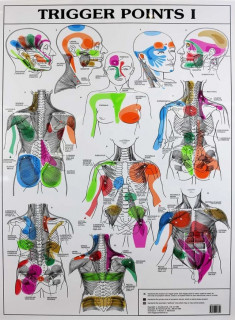
(Myofascial) trigger points are an important cause of most musculoskeletal pain syndromes, plus have a host of other detrimental effects. If you have had experience with these you will probably understand that after treatment the pain usually eventually comes back again. This is because most courses of trigger point therapy just (temporarily) stopping them hurting, not eliminate them. They are still there, so:
In this article we will discuss a strategy that should help eliminate your trigger points properly, including simple home techniques so treatment is convenient and affordable.
In this section we will go over the background information, or if you are just after the treatment skip ahead to the solution.
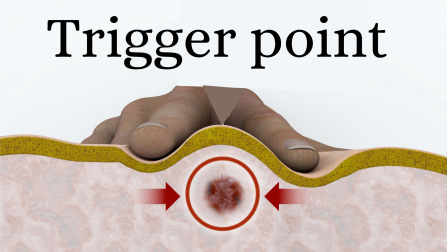
Trigger points are those tender lumps in your muscles that massage therapists find that shoot pain when pressed upon. The lump is part of the muscle that has spasmed or cramped, and because the spasm shortens the muscle that part of the muscle becomes tight. As discussed in our article Your Complete Guide To (Myofascial) Trigger Points , trigger points are a major part of most musculoskeletal pain syndromes such as back, neck and shoulder pain pain (1–4), plus also headaches (5–11). Even when not causing pain trigger points cause problems such as muscle tightness, a loss of strength, fatigue, and impaired neurological control.
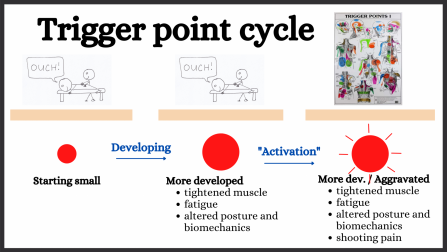
As shown in this diagram trigger points start small and gradually grow over years or decades. At first you will only know they are there if a therapist presses on them. As they grow the muscle will gradually tighten, causing restricted movement and possibly altered posture or fatigue. Eventually something may aggravate the trigger point causing it to spontaneously shoot pain.
You will hear of trigger points being referred to as two types:
These are exactly the same trigger points. It just depends on whether they are shooting pain or not, which as we will see can easily change.
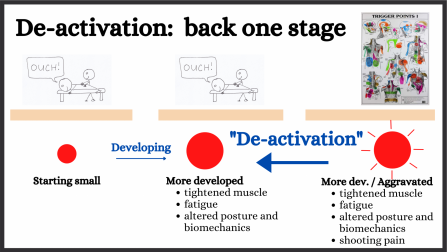
You may feel better after a course of needles, laser or manual trigger point therapies, but what actually happens is as shown by the blue arrow in this diagram. The trigger point is reverted back to the way it was before it was aggravated. As you will see the scientists and industry behind providing these treatments use the term “de-activation”, to create the illusion that their treatments do more than just temporarily stop the pain.
Every scientist who conducts clinical trials does extensive background research studying what has been done before. Therefore, all those conducting trials of trigger point therapies would have studied the proof shown here, that typical courses of trigger point therapy do not eliminate trigger points. Rather than have this inconvenient fact spoil their results they do do the following when they conduct their trials on therapies such as needles or laser:
By doing this the scientists are able to write their trials up as a success. For our research we found over 30 such trials (see summary below). Each claimed that their treatments successfully treated trigger points, where the reality is that all any of them ever proved that was that their expensive courses of therapy give temporary symptom relief. Hoping people do not understand what “de-activation” means these trials are used as follows.
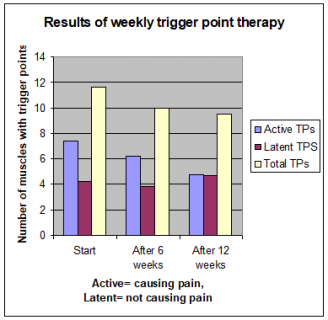
We could only find three clinical trials where scientists checked whether the trigger points were gone, and in all of them they were still there (13–15). The most important was a trial conducted by arguably the best trigger point scientists in the world who did 12 weeks of multiple trigger point therapies and as shown in this diagram from he trial report only eliminated about 1/3 (13). The remaining 2/3 were still there. If such a prolonged and extensive course of treatments provided by the best in the world can only eliminate this few a typical course of needles, laser or manual therapies will have little, if any impact on your trigger point population.
For reasons discussed above most of the clinical trials of trigger point therapy are of little use and arguably deliberately misleading, so to put together the effective solution below we looked at at the following information we do have.
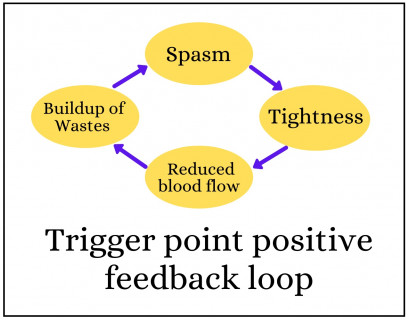
As shown in this diagram the reason trigger points gradually grow is because when parts of the muscle spasm or cramp it causes a chain reaction known as a positive feedback loop. As you can see, the spasm causes the muscle tighten, which puts pressure on the blood vessels causing a restriction in blood flow. Because of the restriction in blood flow there is a build up of waste products which becomes toxic, and this in turn causes more spasm (16–19). Knowing this helps us treat this problem.
This feedback loop can be slowed or stopped by addressing any part or parts of the loop. Each therapy may affect a different part (16–19). This is why there are so many therapies. For example, massage helps relax the muscle, increase blood flow and squeeze out waste products. In our solution section we use a treatment that will address every part.
We need to eliminate the trigger points properly, because as long as the trigger point is there the positive feedback loop will continue and the lump will continue to grow.
While the 12 week trial discussed above showed that typical courses of therapy will not eliminate trigger points they did manage to diminish the trigger points and eliminate some. This tells us that treatments will reduce trigger points and eliminate them over time. The main issue is that the therapy must be continued for long after the pain has gone. If using professional services for all this will be totally impractical and not affordable for most. Because of this our solution section gives therapies you can easily do yourself at home.
If we can reduce or eliminate things that cause trigger points this will help stop them developing or re-forming. In the solution section we look at things you can do.
The basis of our solution is very simple
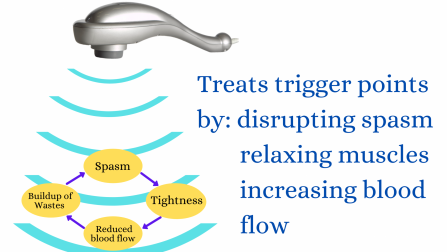
By far your best option for home trigger point therapy is using a vibration massager, but you need the proper equipment ( not a massage gun ). It is very safe and very easy to self apply, and as shown in this diagram it is highly effective because the vibrations penetrate and effect and affect every part of the feedback loop. For details on how to use this therapy please see our article The simple effective way to treat trigger points yourself , or check out the video below.
If you do not have the appropriate equipment there are a variety of self massage techniques where you can use either you hand or a simple tool. For details please see this article or the video above.
As discussed above 12 weeks of very effective therapy managed to eliminate 1/3 of the trigger points, while reducing the others. To properly eliminate trigger points using your home therapy may require 50-100 treatments, but if you can do them at home and it doesn’t cost what does it matter? As long as you are continually improving you can be happy. Simply, what you do is continue the treatments until the pain has gone, then keep going until you can no longer find the trigger points when you examine for them. One you are trigger point free it is good to keep going with some regular but less frequent maintenance.
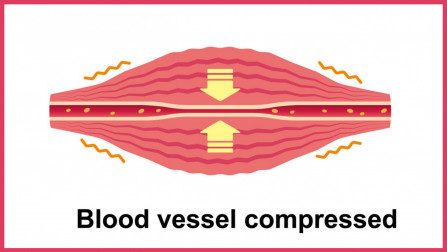
There are many causes of trigger points including injury, muscle overload and emotional stress. However, the biggest cause is where muscle tightness restricts blood blood flow creating an environment of accumulated wastes and reduced nutrients in your muscles. This is why trigger points are so common where postural issues (eg. sitting at a computer) or repetitive activities cause muscle tightness. It is also important to note that psychological and emotional issues can cause your muscle to tense, restricting blood flow and causing trigger points to develop. Here are some basic ways you can help stop trigger points from forming.
The classic example is sitting at a desk, however, there are may other activities that could cause issues. Our government worksafe has this excellent practical reference that covers most situations, including how to set up your chair and desk.
If you are in a situation such as sitting at a desk where your muscles may tighten take regular breaks, doing some light stretches or exercises.
Regular massages or the regular use of any of the the techniques we have shown you will help maintain your circulation.
Is these issues are causing you to tighten your muscles a lot seek some professional help on how to deal with them.
Once you are free of trigger point congratulations. Now you and do things like get regular exercise, avoid things that can cause trigger points, and have regular “maintenance” or “check up” therapy to keep your muscle healthy.
On our website we have a host of guides with specific advice for trigger points in various conditions and various parts of your body. These usually have:
Here a some examples.
Self massage and trigger point therapy for headaches and migraines
Massage and trigger point therapy for low back pains with self help options
Massage and trigger point therapy for calf pain, with self help options
Massage and trigger point therapy for shoulder pain with self help options
Self massage and trigger point therapy for tennis elbow
Does massage help with fibromyalgia, with self help advice
Below is a summary of the findings of several scientific reviews of trigger point therapies (12,20–27). As discussed above these trials deemed "success" to be just a temporary reduction in symptoms, and as you can see they can take a lot of sessions to even achieve that.
Trial results for laser have been marginally better than those for dry needling, but still only temporary relief. Scientists attribute it’s effect to increasing micro-circulation, improving oxygenation and helping remove waste products. However, this is something that can easily be achieved, if not better, by any competent massage therapist.
The big concern with laser is the sheer number of applications of therapy needed for only temporary benefits. For example one trial (28) used 10 daily applications of laser on patients with upper back and neck pain to get a reduction in pain and tenderness for three weeks. Further, according to one review (29) applications of laser should be given from 2-3 times a week though to 5 times a week, with a total of 30 applications of therapy for long term cases. Keep in mind this is just to achieve deactivation, not to eliminate the problem. Assuming each laser consultation costs $50 and takes an hour out of your day that’s $1,500 and 30 hours of your life just for some temporary pain relief, leaving you to front up again next time the problem is aggravated.
Most trials show that dry needling provides some short term pain relief and improved function, and where dry needling had been compared with laser the laser has given slightly better results. Again, you are going to need a lot of needles for very little benefits.
There are various types of manual therapies that involve pressure, massage and stretching of muscles. The trial results for them tend to be similar to those of laser and dry needling. However, according to one review (21) one study did show residual benefit after six months.

If you wish to try this therapy DrGraeme vibration massagers were originally built by Dr Graeme for use in his clinic, and to prescribe to his patients for additional self use at home. Now these are used by colleagues and other professionals for similar purposes. If you are a professional and wish to know more about this therapy, or possibly get a sample massager to trial please check out our practitioner page .
We are continually adding more information on research and uses. Subscribe below to have us email them to you "hot off the press".

Several years ago Dr Graeme, a Chiropractor practicing in Victoria, Australia was looking for a serious hand held massager his patients could use at home to get the extra quality massage they needed. The ones he found in the shops and on-line for home use looked nice but were not serious, and... read more
Vibration massage has been used by professionals for decades, but more recently personal use machines have made this therapy available... Read Article
(Myofascial) trigger points are an important cause of most musculoskeletal pain syndromes, plus have a host of other detrimental effects.... Read Article
The results of several clinical trials show that common tension headaches are typically caused by trigger points in the following... Read Article
When we look at the root cause of fibromyalgia we need to look at two levels: 1. the malfunction of the nervous system which causes the... Read Article
Sports massages are widely used and come with a host of claims such as that they increase performance and help recovery. However, when... Read Article
As a Chiropractor for over 27 years a lot of information I’ve seen about chiropractic adjustments has been misleading or just plain... Read Article
To become fitter, stronger and faster your need to push your body to create the microscopic damage that stimulates improvement. That... Read Article
Tennis elbow is considered a difficult condition and too often does not respond to treatments, but this does not have to be. As I... Read Article
Massage is said to help healing and recovery. It certainly does, and in this article I’ll show you scientific evidence of some pretty... Read Article
Do not refresh or leave this page until loading complete.